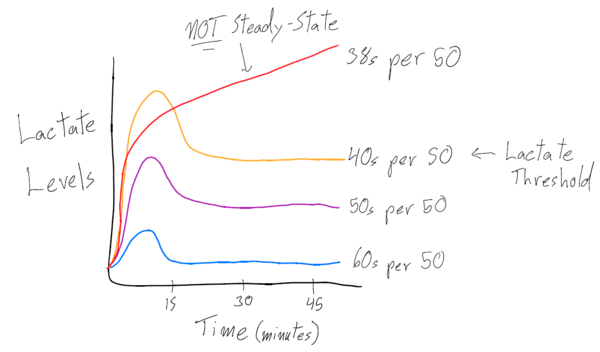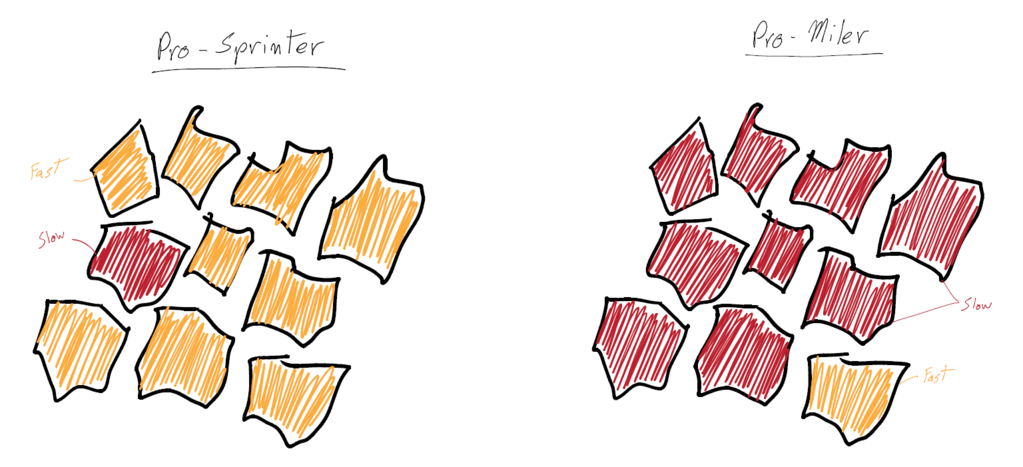The Truth About Lactate Threshold
January 11, 2019
Swimmers often encounter lactate sets throughout their training, yet several misconceptions exist about the body’s production of lactic acid and experiences of fatigue. Let’s start off with getting our definitions straight. The term “lactate threshold” is the maximum speed you can maintain without quickly tiring out. And while lactate is certainly associated with high levels of intense work (and can be measured easily with a blood sample), lactic acid simply does not exist within the body – our pH is too high. Lactate is actually a byproduct of fast energy breakdown that occurs during short, powerful bursts of work. It plays a positive role in the body and can indicate our level of fitness.

So if lactate and lactic acid don’t make us fatigued, then what causes the burning in your muscles while swimming fast? Here’s the true (and long) answer: the glycolysis process, which breaks down carbohydrates and other molecules to produce ATP. ATP is broken down during exercise, which produces energy and hydrogen molecules throughout the muscles. This buildup of hydrogen molecules is what causes the body’s pH to drop, making it more acidic and interfering with the muscle fiber’s ability to contract. When this occurs, it won’t be long before the swimmer has to shut down the intensity.
The glycolysis process produces pyruvate from the breakdown of carbohydrate, which subsequently bond with the hydrogen ions to create lactate in order to buffer the acid and help the body recover. During intense swimming, pyruvate cannot keep up with all of the hydrogen ions as they are being produced; thus, the excess hydrogen ions is what causes the burn and fatigue during swims. Lactate is often associated with the soreness encountered during intense workouts, so we will continue to refer to it as such.
Lactate threshold levels are determined by how well a swimmer’s body clears the hydrogen ions that are created. The faster the speed, the higher the rate of energy breakdown with subsequent higher levels of lactate. To find the maximum speed without overloading the body with acid, the goal is to improve the body’s ability to get rid of the lactate as quickly as possible once it starts to form. However, most people generate a lot more lactate than they are capable of clearing at high intensities.

A way to measure the swimmer’s lactate levels is performing a lactate threshold set. If a swimmer starts off at a slower pace for 50s, lactate initially goes up for about 15 minutes or so, then decreases and is at a constant rate for a long time. If they are asked to swim at a faster pace, the lactate level spikes and then comes back down at a steady rate, but all at a higher level than before. Lastly, say the swimmer was asked to swim at an even faster pace than the first two times. The lactate shoots up high for the first few minutes, but then the swimmer starts to slow down and is unable to hold the pace anymore.
Looking at the diagram above, each line represents a specific intensity at which the swimmer completed the same distance, testing out which effort was at their lactate threshold. The red line depicts the athlete experiencing an exponential increase in lactate – the point at which the swimmer has reached their body’s threshold level of being able to clear lactate and metabolic waste product. Because the lactate levels did not come back down or level out from the initial spike, this swimmer found their threshold – the fastest pace speed they could maintain without the lactate levels skyrocketing.
Sprinters versus milers is a common comparison in lactate threshold. If a sprinter and a miler raced in a 100, the sprinter would win. This is because the race was not long enough for the lactate to build up and shut down the sprinter’s body. However, the sprinter’s lactate levels would be higher than a miler’s in a 100 race, because the sprinter is able to produce a lot of power from their glycolytic system, which results in a lot of lactate creation from the anaerobic emphasis. The miler is not able to produce a lot of power through the glycolytic system; thus, they struggle to produce high speed and a high level of lactate. The miler’s aerobic system is so efficient and programmed toward longer, less intense races, that it isn’t used to producing short bouts of speed and power.

Many of the differences between a sprinter and a miler are genetic. Slow and fast twitch fibers greatly differ in lactate production. Milers have a lot of slow twitch fibers, which do not make a lot of acid (due to the aerobic nature of the muscle fibers), so they do not fatigue as easily. However, sprinters have a lot of fast twitch fibers, which produce massive amounts of power and lactate as a byproduct.
Another aspect that changes the peak lactate level is nutrition and recovery. By eating a low carb diet, the peak lactate level a swimmer can achieve will decrease by 25 percent. However, by eating a high carb diet, the peak lactate level a swimmer can achieve will increase 25 percent. This occurs largely due to the reliance on carbohydrate breakdown during short sprints through the glycolytic energy system.
All in all, the more swimmers practice doing lactate sets, the better they become. Raising your lactate threshold is a sign of becoming fitter and faster. Peak lactate levels can change, and the ability to produce higher levels can indicate improvement in performance. Since swimmers all over the world are pushing the peak higher and higher, the world of swimming just keeps getting faster and faster.
Recent Articles
Dylan Carter
Chelsea Hodges
Lorenzo Zazzeri

Introducing the Stability Snorkel Jr
Share on Social Media


